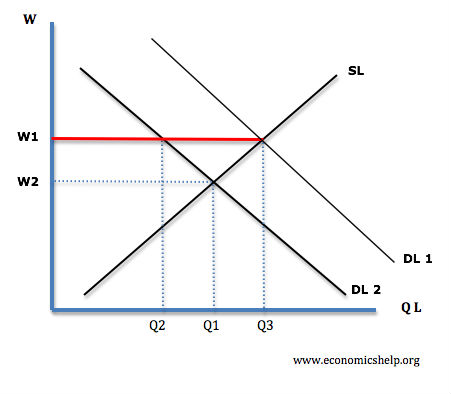New Keynesianism refers to a branch of Keynesian economics which places greater stress on microeconomic foundations to explain macro-economic disequilibrium. A key element of new Keynesianism is the role of wage rigidities and price rigidities to explain the persistence of unemployment and macro economic disequilibrium.
New Keynesianism combines elements of traditional Keynesianism (sometimes referred to as old Keynesianism) with classical theory.
Elements of New Keynesianism
- Many markets are imperfectly competitive (have a degree of monopoly power). Therefore firms have the ability to set prices, and firms may often be reluctant to cut prices – leading to price rigidity.
- Many labour markets are imperfect. In particular, wages can be ‘sticky downwards’ e.g. both unions and firms both resist nominal wage cuts.
- If there is a shock to the economy, such as a short-term fall in demand, markets don’t clear, and we end up with real wage unemployment.
- Real interest rates may depart from the ‘natural interest rate’. The job of monetary authorities is to restore the correct interest rate to avoid macro-economic instability.

This diagram shows how a fall in demand for labour causes unemployment – if there are wage rigidities which keep wages at W1 and not fall to W2.
- New Keynesians believe there is a role for monetary and fiscal policy to play a role in stabilising the economy and reducing unemployment. However, they tend to favour monetary policy.
- New Keynesians place a greater emphasis on development models from microeconomic behaviour to predict macro-economic outcomes. These models are known as Dynamic stochastic general equilibrium (DSGE).
- A very simplified understanding of these models could be gained from the basic Taylor rule – The Taylor rule suggests the optimal interest rates given the rate of inflation and the output gap.
- Some New Keynesian models, e.g. by Blanchard have stressed aiming at low inflation (e.g. optimal inflation target of 2%) These models state that targeting the optimal inflation rate also leads to an optimal rate of growth and unemployment. (This is sometimes known as the divine coincidence, though the breakdown of the great moderation has undermined the predominance of low inflation targetting.
Importance of price and wage rigidities in new Keynesianism.
Why are prices rigid
- Firms incur costs in changing prices. Therefore, they prefer to leave them unchanged.
- Reducing prices can increase real incomes for consumers, which might be spent on other goods (firm doesn’t benefit)
- Demand is inelastic in imperfect competition; there is no incentive to cut prices as revenue falls.
- Staggering of prices. Firms may respond to changing prices slowly. If one firm cuts price of raw materials, it may take a few months for retailers to pass this cost saving onto consumers.
Why wages are rigid
- Trade unions resist wage cuts for their workers.
- Workers are mainly concerned about their wage, and not the overall level of employment (e.g. it would be hard to sell a wage cut on the grounds it would reduce unemployment)
- Efficiency wage theory. Cutting wages may reduce worker morale and reduce productivity.
Neo-Classical Synthesis (Neo Keynesianism) and New Keynesianism.
Although these two schools are considered to be different schools, they share several features. They both focus on more micro-economic foundations of macro-economic theory, and are more accepting of the classical view in the long-run. The Neo Keynesians were the first to emerge after the Second World War, with P Samuelson being an important populariser of this ‘watered down version’ of Keynesianism. New Keynesianism developed later and places greater importance on DSGE modelling and rational expectations.
Further reading
- New Keynesianism – Greg Mankiw
Related

I’m puzzled as to what the big difference is between Keynes and “new Keynsians”. As to wage rigidities, it was KEYNES HIMSELF who coined the phrase “sticky downwards” in relation to wages.
As to other market imperfections, I very much doubt that Keynes himself thought that all prices changed instantaneously to reflect supply and demand.
New Keynesians seem to place less stress on actual demand management, placing more emphasis on micro economic imperfections rather than deficiency of AD. I think it was Joan Robinson who referred to these types of ‘Keynesians’ as ‘Bastard Keynesians’ because they ignored the most fundamental aspect of Keynes theory.